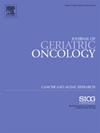Trends in the use of granulocyte colony stimulating factors for older patients with cancer, 2010 to 2019
IF 3
3区 医学
Q3 GERIATRICS & GERONTOLOGY
引用次数: 0
Abstract
Introduction
Older patients with cancer receiving myelosuppressive treatment are at an increased risk for developing febrile neutropenia (FN) or having chemotherapy dose-reductions or delays, resulting in suboptimal health outcomes. Granulocyte colony stimulating factors (G-CSF) are effective medications to reduce these adverse events and are recommended for patients 65 years receiving chemotherapy with >10 % FN risk. We sought to characterize the trends and predictors of G-CSF use between the youngest-old (66–74 years), middle-old (75–84 years), and oldest-old (85 years) patients with cancer.
Materials and Methods
We used registry data from SEER-Medicare for breast, lung, ovarian, colorectal, esophageal, gastric, uterine, prostate, pancreatic cancer, and non-Hodgkin lymphoma (NHL) diagnoses from 2010 to 2019. Cox proportional hazard analysis was used.
Results
Overall, 41.4 % of patients received G-CSF from chemotherapy initiation to three days after completion of the first chemotherapy course. The use rate remained relatively stable for all cancers, except for an increase in use for those with pancreatic cancer. G-CSF use decreased as patients got older. The oldest-old were 43.0 % (95 % confidence interval: 40.7–45.2 %) less likely to receive G-CSF compared to the youngest-old. Patients with breast cancer or NHL were more likely to receive G-CSF than those with other cancers. Patients who were female, married, White or Hispanic, and had fewer comorbidities were more likely to receive G-CSF.
Discussion
G-CSF is used less often in populations at higher risk of developing FN and related complications. Improving adherence to recommendations can improve health outcomes, especially in the oldest adults, older males, and Black patients.
2010 年至 2019 年老年癌症患者使用粒细胞集落刺激因子的趋势。
简介接受骨髓抑制治疗的老年癌症患者发生发热性中性粒细胞减少症(FN)或化疗剂量减少或延迟的风险增加,从而导致不理想的健康状况。粒细胞集落刺激因子(G-CSF)是减少这些不良事件的有效药物,建议年龄≥65 岁、接受化疗且 FN 风险大于 10% 的患者使用。我们试图描述最年轻(66-74 岁)、中等年龄(75-84 岁)和最年长(≥85 岁)癌症患者使用 G-CSF 的趋势和预测因素:我们使用了SEER-Medicare的登记数据,包括2010年至2019年诊断的乳腺癌、肺癌、卵巢癌、结直肠癌、食管癌、胃癌、子宫癌、前列腺癌、胰腺癌和非霍奇金淋巴瘤(NHL)。研究采用了 Cox 比例危险分析法:总体而言,41.4%的患者在化疗开始至首个化疗疗程结束后三天内接受了G-CSF治疗。除了胰腺癌患者的使用率有所上升外,所有癌症的使用率都保持相对稳定。随着患者年龄的增长,G-CSF 的使用率也在下降。与最年轻的患者相比,年龄最大的患者接受 G-CSF 治疗的几率要低 43.0%(95% 置信区间:40.7-45.2%)。乳腺癌或 NHL 患者比其他癌症患者更有可能接受 G-CSF。女性、已婚、白人或西班牙裔、合并症较少的患者更有可能接受 G-CSF:讨论:G-CSF在罹患FN及相关并发症风险较高的人群中使用较少。提高对建议的依从性可以改善健康状况,尤其是对最年长的成年人、老年男性和黑人患者。
本文章由计算机程序翻译,如有差异,请以英文原文为准。
求助全文
约1分钟内获得全文
求助全文
来源期刊

Journal of geriatric oncology
ONCOLOGY-GERIATRICS & GERONTOLOGY
CiteScore
5.30
自引率
10.00%
发文量
379
审稿时长
80 days
期刊介绍:
The Journal of Geriatric Oncology is an international, multidisciplinary journal which is focused on advancing research in the treatment and survivorship issues of older adults with cancer, as well as literature relevant to education and policy development in geriatric oncology.
The journal welcomes the submission of manuscripts in the following categories:
• Original research articles
• Review articles
• Clinical trials
• Education and training articles
• Short communications
• Perspectives
• Meeting reports
• Letters to the Editor.
 求助内容:
求助内容: 应助结果提醒方式:
应助结果提醒方式:


